People Management Strategies: Leadership, Training & Talent in NHS
VerifiedAdded on 2023/06/18
|8
|2573
|207
Report
AI Summary
This report provides an analysis of people management within the National Health Service (NHS), focusing on three key areas: leadership and management, training and development, and talent management. It assesses the operational context of the NHS, highlighting the importance of effective leadership and management styles, particularly consensus-based approaches. The report also explores the significance of training and development in enhancing employee skills and morale, recommending regular training sessions and a positive workplace environment. Furthermore, it examines talent management strategies, emphasizing the need to recruit, develop, retain, and reward talented employees to ensure the organization's goals are met. The report concludes with recommendations for improving management theories, training practices, and talent management mechanisms within the NHS to create a more effective and efficient workforce. Desklib provides access to similar solved assignments and resources for students.
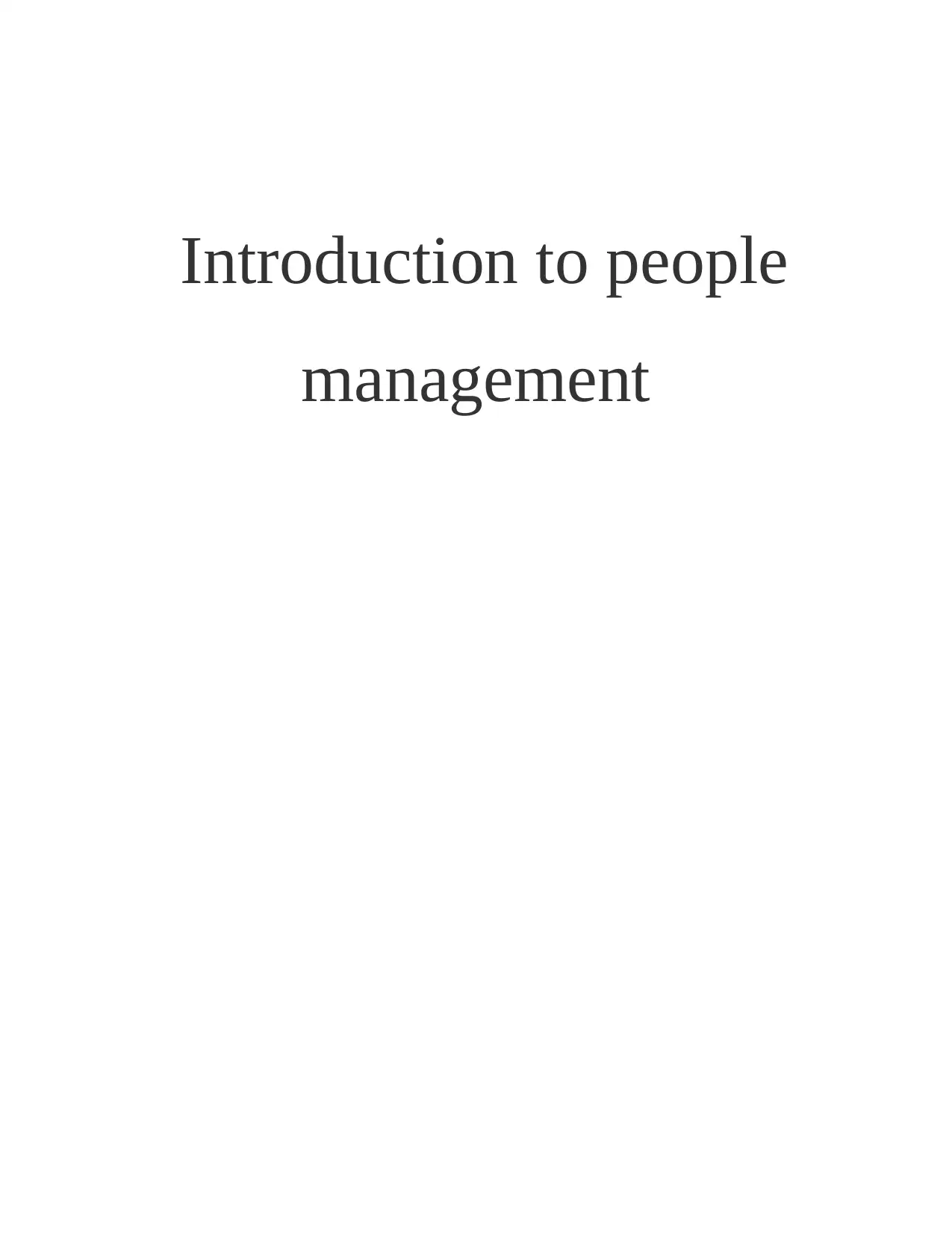
Introduction to people
management
management
Paraphrase This Document
Need a fresh take? Get an instant paraphrase of this document with our AI Paraphraser
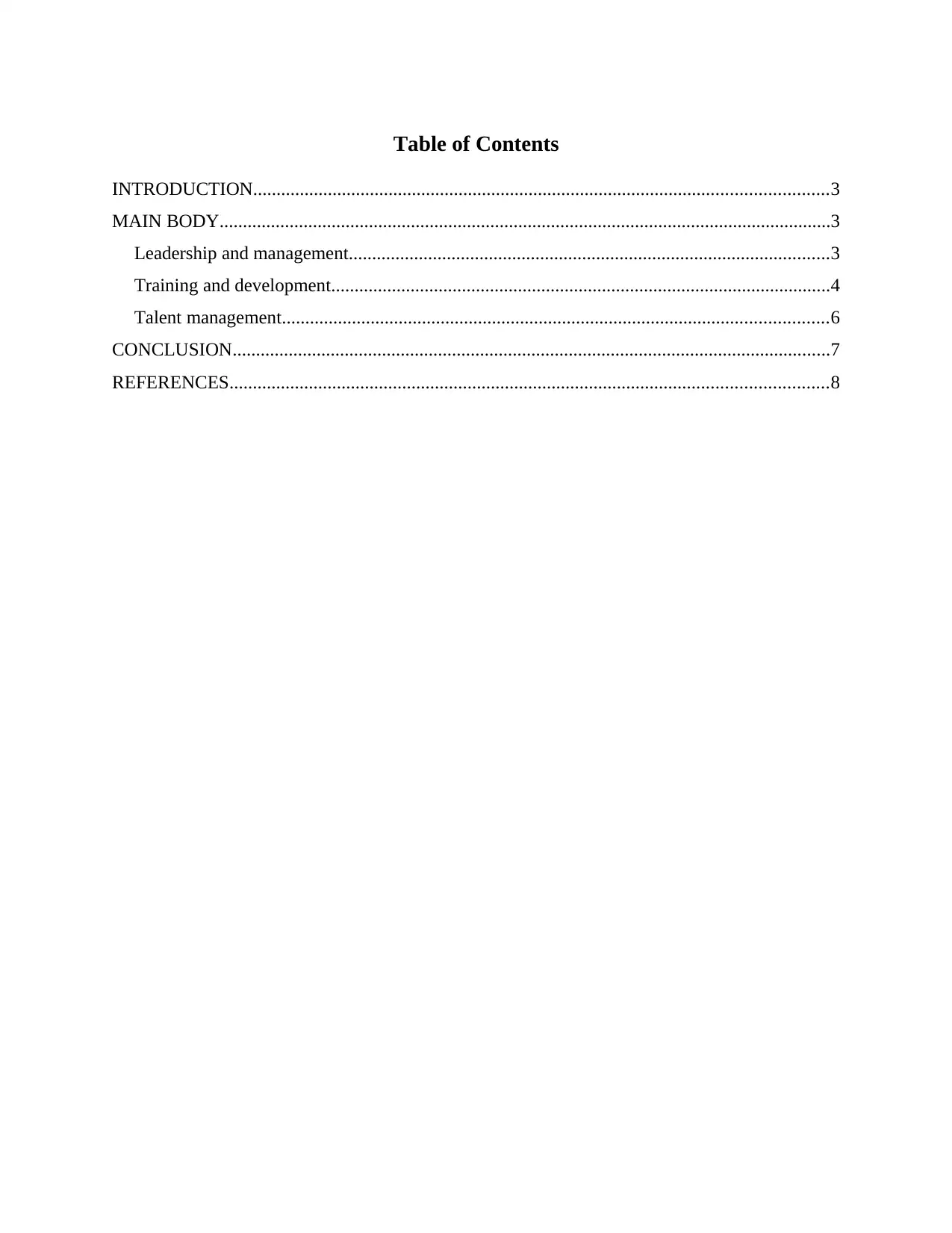
Table of Contents
INTRODUCTION...........................................................................................................................3
MAIN BODY...................................................................................................................................3
Leadership and management.......................................................................................................3
Training and development...........................................................................................................4
Talent management.....................................................................................................................6
CONCLUSION................................................................................................................................7
REFERENCES................................................................................................................................8
INTRODUCTION...........................................................................................................................3
MAIN BODY...................................................................................................................................3
Leadership and management.......................................................................................................3
Training and development...........................................................................................................4
Talent management.....................................................................................................................6
CONCLUSION................................................................................................................................7
REFERENCES................................................................................................................................8
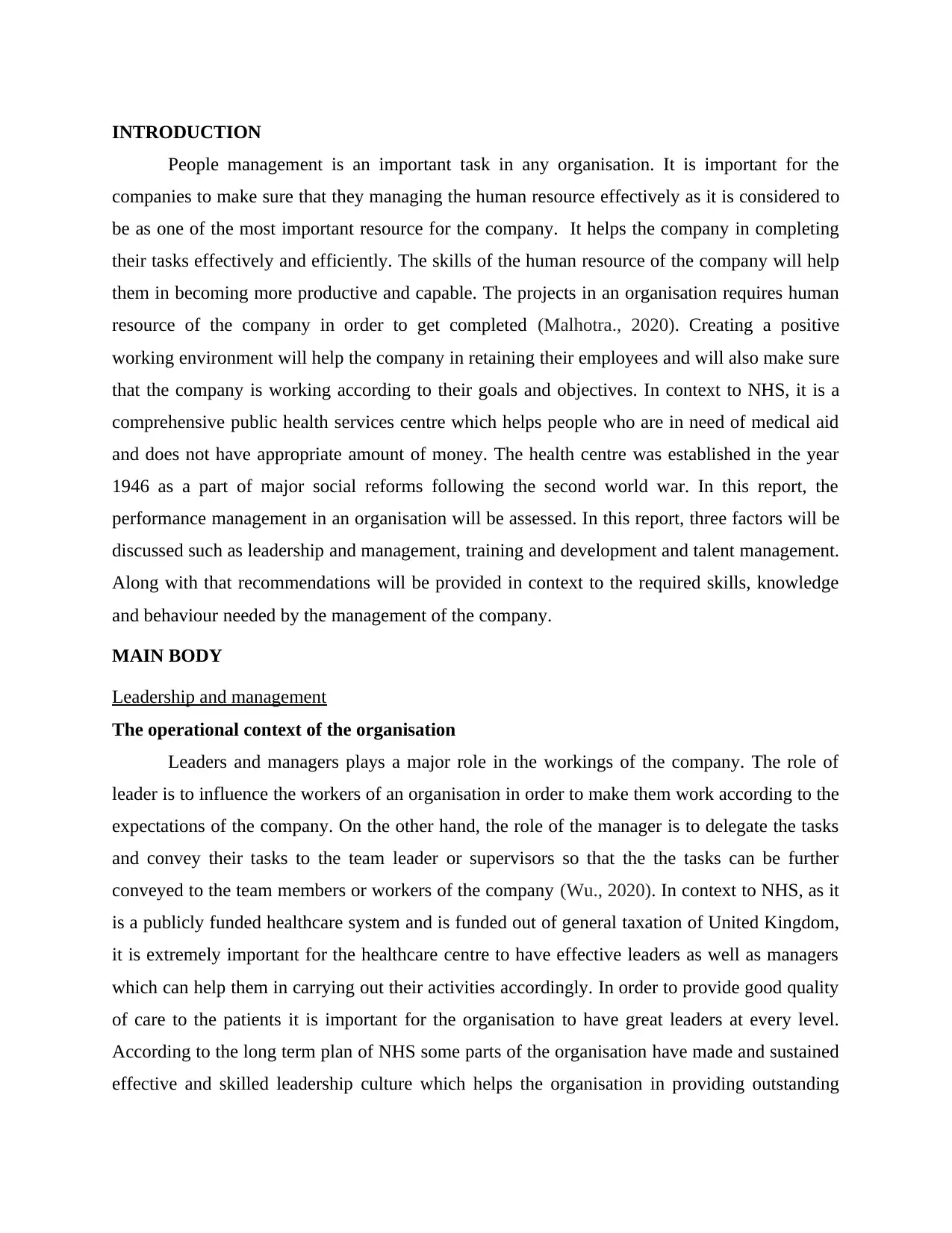
INTRODUCTION
People management is an important task in any organisation. It is important for the
companies to make sure that they managing the human resource effectively as it is considered to
be as one of the most important resource for the company. It helps the company in completing
their tasks effectively and efficiently. The skills of the human resource of the company will help
them in becoming more productive and capable. The projects in an organisation requires human
resource of the company in order to get completed (Malhotra., 2020). Creating a positive
working environment will help the company in retaining their employees and will also make sure
that the company is working according to their goals and objectives. In context to NHS, it is a
comprehensive public health services centre which helps people who are in need of medical aid
and does not have appropriate amount of money. The health centre was established in the year
1946 as a part of major social reforms following the second world war. In this report, the
performance management in an organisation will be assessed. In this report, three factors will be
discussed such as leadership and management, training and development and talent management.
Along with that recommendations will be provided in context to the required skills, knowledge
and behaviour needed by the management of the company.
MAIN BODY
Leadership and management
The operational context of the organisation
Leaders and managers plays a major role in the workings of the company. The role of
leader is to influence the workers of an organisation in order to make them work according to the
expectations of the company. On the other hand, the role of the manager is to delegate the tasks
and convey their tasks to the team leader or supervisors so that the the tasks can be further
conveyed to the team members or workers of the company (Wu., 2020). In context to NHS, as it
is a publicly funded healthcare system and is funded out of general taxation of United Kingdom,
it is extremely important for the healthcare centre to have effective leaders as well as managers
which can help them in carrying out their activities accordingly. In order to provide good quality
of care to the patients it is important for the organisation to have great leaders at every level.
According to the long term plan of NHS some parts of the organisation have made and sustained
effective and skilled leadership culture which helps the organisation in providing outstanding
People management is an important task in any organisation. It is important for the
companies to make sure that they managing the human resource effectively as it is considered to
be as one of the most important resource for the company. It helps the company in completing
their tasks effectively and efficiently. The skills of the human resource of the company will help
them in becoming more productive and capable. The projects in an organisation requires human
resource of the company in order to get completed (Malhotra., 2020). Creating a positive
working environment will help the company in retaining their employees and will also make sure
that the company is working according to their goals and objectives. In context to NHS, it is a
comprehensive public health services centre which helps people who are in need of medical aid
and does not have appropriate amount of money. The health centre was established in the year
1946 as a part of major social reforms following the second world war. In this report, the
performance management in an organisation will be assessed. In this report, three factors will be
discussed such as leadership and management, training and development and talent management.
Along with that recommendations will be provided in context to the required skills, knowledge
and behaviour needed by the management of the company.
MAIN BODY
Leadership and management
The operational context of the organisation
Leaders and managers plays a major role in the workings of the company. The role of
leader is to influence the workers of an organisation in order to make them work according to the
expectations of the company. On the other hand, the role of the manager is to delegate the tasks
and convey their tasks to the team leader or supervisors so that the the tasks can be further
conveyed to the team members or workers of the company (Wu., 2020). In context to NHS, as it
is a publicly funded healthcare system and is funded out of general taxation of United Kingdom,
it is extremely important for the healthcare centre to have effective leaders as well as managers
which can help them in carrying out their activities accordingly. In order to provide good quality
of care to the patients it is important for the organisation to have great leaders at every level.
According to the long term plan of NHS some parts of the organisation have made and sustained
effective and skilled leadership culture which helps the organisation in providing outstanding
⊘ This is a preview!⊘
Do you want full access?
Subscribe today to unlock all pages.

Trusted by 1+ million students worldwide
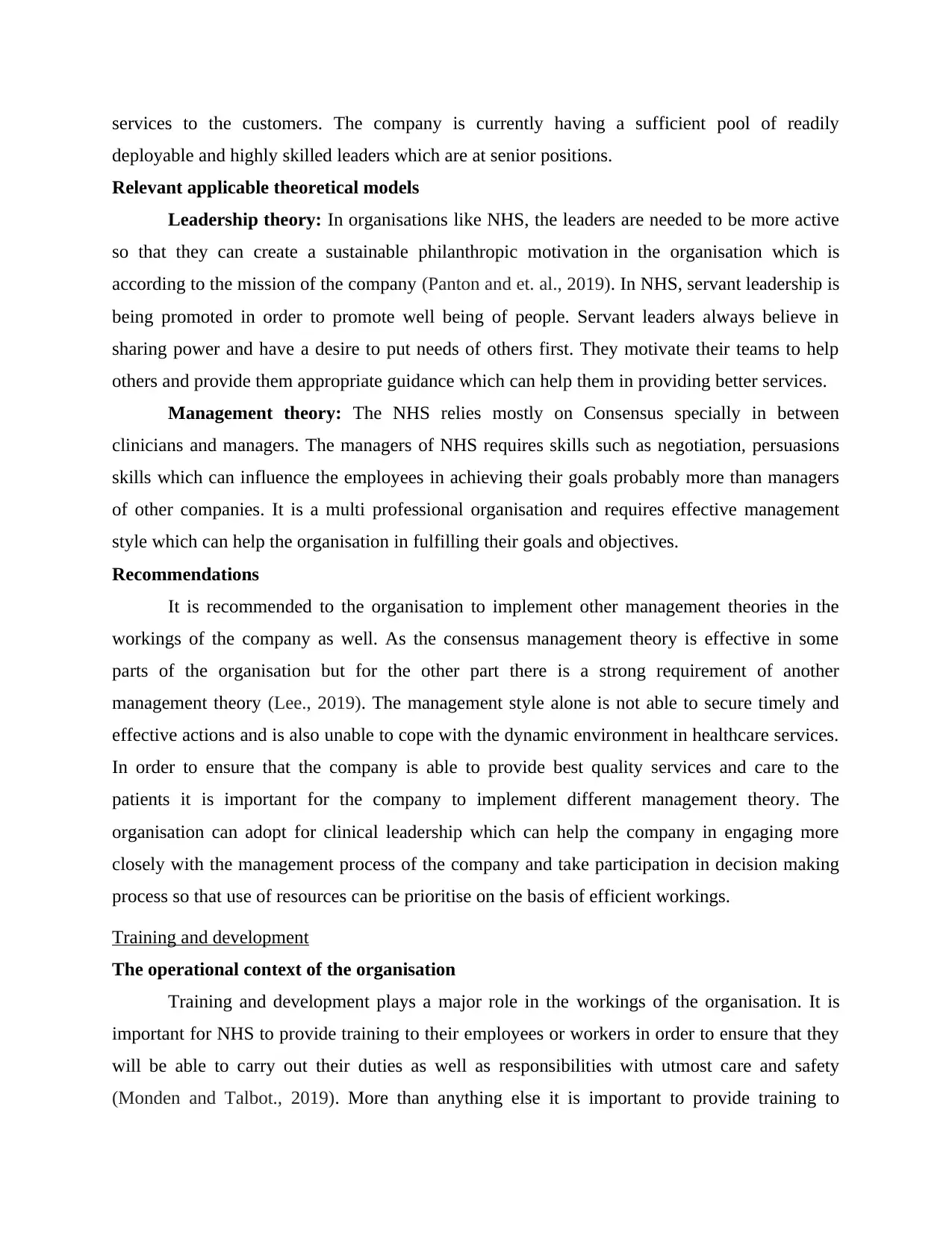
services to the customers. The company is currently having a sufficient pool of readily
deployable and highly skilled leaders which are at senior positions.
Relevant applicable theoretical models
Leadership theory: In organisations like NHS, the leaders are needed to be more active
so that they can create a sustainable philanthropic motivation in the organisation which is
according to the mission of the company (Panton and et. al., 2019). In NHS, servant leadership is
being promoted in order to promote well being of people. Servant leaders always believe in
sharing power and have a desire to put needs of others first. They motivate their teams to help
others and provide them appropriate guidance which can help them in providing better services.
Management theory: The NHS relies mostly on Consensus specially in between
clinicians and managers. The managers of NHS requires skills such as negotiation, persuasions
skills which can influence the employees in achieving their goals probably more than managers
of other companies. It is a multi professional organisation and requires effective management
style which can help the organisation in fulfilling their goals and objectives.
Recommendations
It is recommended to the organisation to implement other management theories in the
workings of the company as well. As the consensus management theory is effective in some
parts of the organisation but for the other part there is a strong requirement of another
management theory (Lee., 2019). The management style alone is not able to secure timely and
effective actions and is also unable to cope with the dynamic environment in healthcare services.
In order to ensure that the company is able to provide best quality services and care to the
patients it is important for the company to implement different management theory. The
organisation can adopt for clinical leadership which can help the company in engaging more
closely with the management process of the company and take participation in decision making
process so that use of resources can be prioritise on the basis of efficient workings.
Training and development
The operational context of the organisation
Training and development plays a major role in the workings of the organisation. It is
important for NHS to provide training to their employees or workers in order to ensure that they
will be able to carry out their duties as well as responsibilities with utmost care and safety
(Monden and Talbot., 2019). More than anything else it is important to provide training to
deployable and highly skilled leaders which are at senior positions.
Relevant applicable theoretical models
Leadership theory: In organisations like NHS, the leaders are needed to be more active
so that they can create a sustainable philanthropic motivation in the organisation which is
according to the mission of the company (Panton and et. al., 2019). In NHS, servant leadership is
being promoted in order to promote well being of people. Servant leaders always believe in
sharing power and have a desire to put needs of others first. They motivate their teams to help
others and provide them appropriate guidance which can help them in providing better services.
Management theory: The NHS relies mostly on Consensus specially in between
clinicians and managers. The managers of NHS requires skills such as negotiation, persuasions
skills which can influence the employees in achieving their goals probably more than managers
of other companies. It is a multi professional organisation and requires effective management
style which can help the organisation in fulfilling their goals and objectives.
Recommendations
It is recommended to the organisation to implement other management theories in the
workings of the company as well. As the consensus management theory is effective in some
parts of the organisation but for the other part there is a strong requirement of another
management theory (Lee., 2019). The management style alone is not able to secure timely and
effective actions and is also unable to cope with the dynamic environment in healthcare services.
In order to ensure that the company is able to provide best quality services and care to the
patients it is important for the company to implement different management theory. The
organisation can adopt for clinical leadership which can help the company in engaging more
closely with the management process of the company and take participation in decision making
process so that use of resources can be prioritise on the basis of efficient workings.
Training and development
The operational context of the organisation
Training and development plays a major role in the workings of the organisation. It is
important for NHS to provide training to their employees or workers in order to ensure that they
will be able to carry out their duties as well as responsibilities with utmost care and safety
(Monden and Talbot., 2019). More than anything else it is important to provide training to
Paraphrase This Document
Need a fresh take? Get an instant paraphrase of this document with our AI Paraphraser
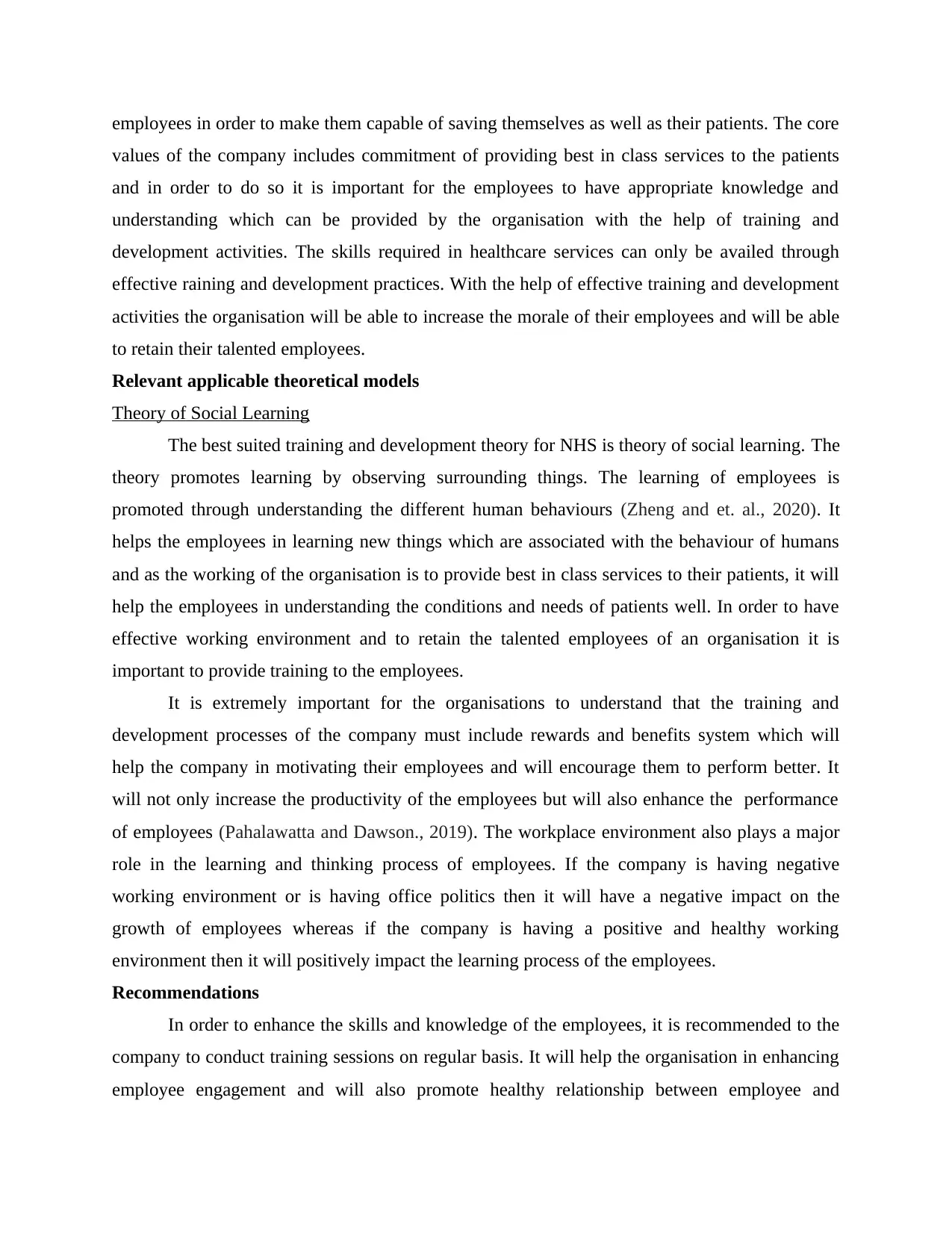
employees in order to make them capable of saving themselves as well as their patients. The core
values of the company includes commitment of providing best in class services to the patients
and in order to do so it is important for the employees to have appropriate knowledge and
understanding which can be provided by the organisation with the help of training and
development activities. The skills required in healthcare services can only be availed through
effective raining and development practices. With the help of effective training and development
activities the organisation will be able to increase the morale of their employees and will be able
to retain their talented employees.
Relevant applicable theoretical models
Theory of Social Learning
The best suited training and development theory for NHS is theory of social learning. The
theory promotes learning by observing surrounding things. The learning of employees is
promoted through understanding the different human behaviours (Zheng and et. al., 2020). It
helps the employees in learning new things which are associated with the behaviour of humans
and as the working of the organisation is to provide best in class services to their patients, it will
help the employees in understanding the conditions and needs of patients well. In order to have
effective working environment and to retain the talented employees of an organisation it is
important to provide training to the employees.
It is extremely important for the organisations to understand that the training and
development processes of the company must include rewards and benefits system which will
help the company in motivating their employees and will encourage them to perform better. It
will not only increase the productivity of the employees but will also enhance the performance
of employees (Pahalawatta and Dawson., 2019). The workplace environment also plays a major
role in the learning and thinking process of employees. If the company is having negative
working environment or is having office politics then it will have a negative impact on the
growth of employees whereas if the company is having a positive and healthy working
environment then it will positively impact the learning process of the employees.
Recommendations
In order to enhance the skills and knowledge of the employees, it is recommended to the
company to conduct training sessions on regular basis. It will help the organisation in enhancing
employee engagement and will also promote healthy relationship between employee and
values of the company includes commitment of providing best in class services to the patients
and in order to do so it is important for the employees to have appropriate knowledge and
understanding which can be provided by the organisation with the help of training and
development activities. The skills required in healthcare services can only be availed through
effective raining and development practices. With the help of effective training and development
activities the organisation will be able to increase the morale of their employees and will be able
to retain their talented employees.
Relevant applicable theoretical models
Theory of Social Learning
The best suited training and development theory for NHS is theory of social learning. The
theory promotes learning by observing surrounding things. The learning of employees is
promoted through understanding the different human behaviours (Zheng and et. al., 2020). It
helps the employees in learning new things which are associated with the behaviour of humans
and as the working of the organisation is to provide best in class services to their patients, it will
help the employees in understanding the conditions and needs of patients well. In order to have
effective working environment and to retain the talented employees of an organisation it is
important to provide training to the employees.
It is extremely important for the organisations to understand that the training and
development processes of the company must include rewards and benefits system which will
help the company in motivating their employees and will encourage them to perform better. It
will not only increase the productivity of the employees but will also enhance the performance
of employees (Pahalawatta and Dawson., 2019). The workplace environment also plays a major
role in the learning and thinking process of employees. If the company is having negative
working environment or is having office politics then it will have a negative impact on the
growth of employees whereas if the company is having a positive and healthy working
environment then it will positively impact the learning process of the employees.
Recommendations
In order to enhance the skills and knowledge of the employees, it is recommended to the
company to conduct training sessions on regular basis. It will help the organisation in enhancing
employee engagement and will also promote healthy relationship between employee and
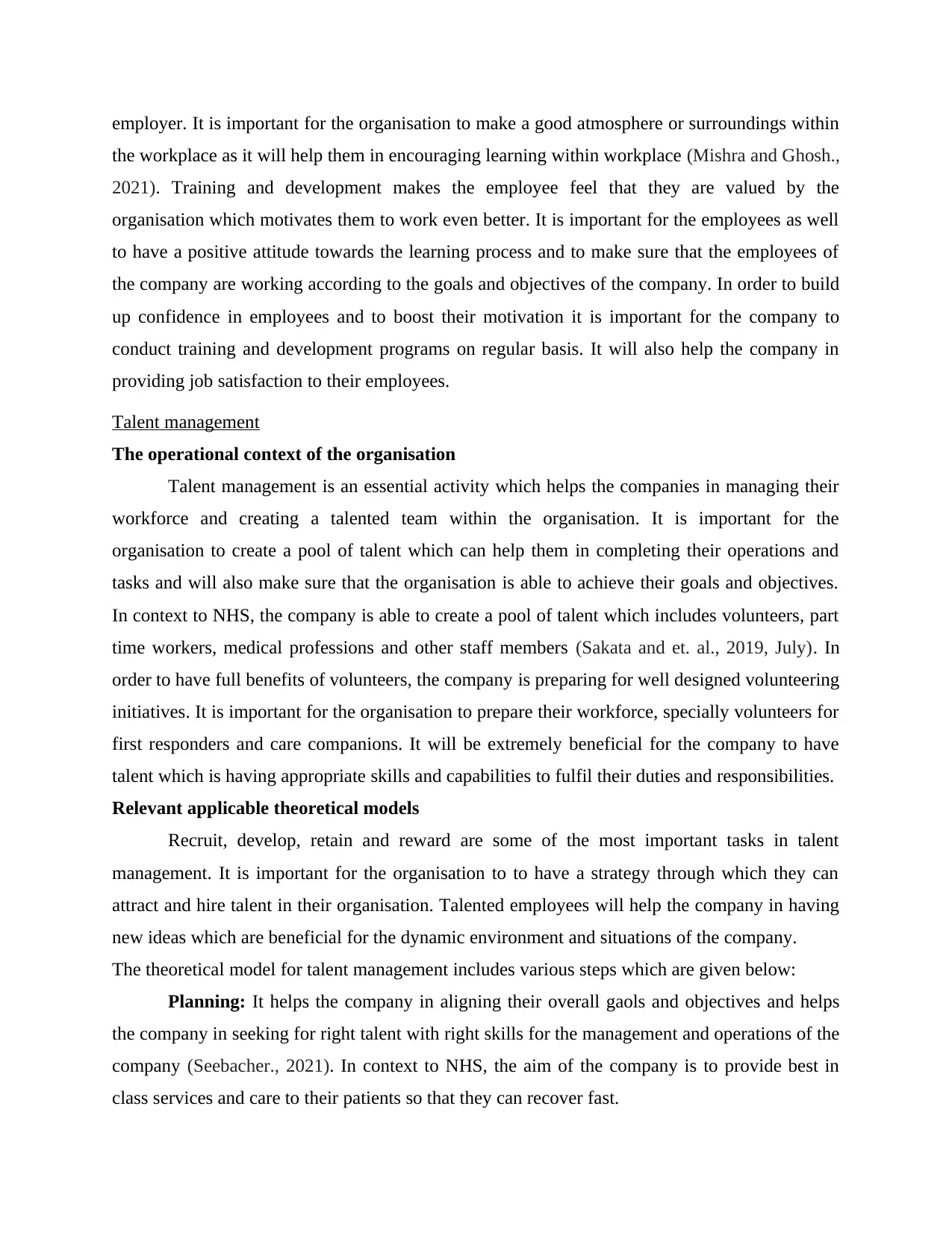
employer. It is important for the organisation to make a good atmosphere or surroundings within
the workplace as it will help them in encouraging learning within workplace (Mishra and Ghosh.,
2021). Training and development makes the employee feel that they are valued by the
organisation which motivates them to work even better. It is important for the employees as well
to have a positive attitude towards the learning process and to make sure that the employees of
the company are working according to the goals and objectives of the company. In order to build
up confidence in employees and to boost their motivation it is important for the company to
conduct training and development programs on regular basis. It will also help the company in
providing job satisfaction to their employees.
Talent management
The operational context of the organisation
Talent management is an essential activity which helps the companies in managing their
workforce and creating a talented team within the organisation. It is important for the
organisation to create a pool of talent which can help them in completing their operations and
tasks and will also make sure that the organisation is able to achieve their goals and objectives.
In context to NHS, the company is able to create a pool of talent which includes volunteers, part
time workers, medical professions and other staff members (Sakata and et. al., 2019, July). In
order to have full benefits of volunteers, the company is preparing for well designed volunteering
initiatives. It is important for the organisation to prepare their workforce, specially volunteers for
first responders and care companions. It will be extremely beneficial for the company to have
talent which is having appropriate skills and capabilities to fulfil their duties and responsibilities.
Relevant applicable theoretical models
Recruit, develop, retain and reward are some of the most important tasks in talent
management. It is important for the organisation to to have a strategy through which they can
attract and hire talent in their organisation. Talented employees will help the company in having
new ideas which are beneficial for the dynamic environment and situations of the company.
The theoretical model for talent management includes various steps which are given below:
Planning: It helps the company in aligning their overall gaols and objectives and helps
the company in seeking for right talent with right skills for the management and operations of the
company (Seebacher., 2021). In context to NHS, the aim of the company is to provide best in
class services and care to their patients so that they can recover fast.
the workplace as it will help them in encouraging learning within workplace (Mishra and Ghosh.,
2021). Training and development makes the employee feel that they are valued by the
organisation which motivates them to work even better. It is important for the employees as well
to have a positive attitude towards the learning process and to make sure that the employees of
the company are working according to the goals and objectives of the company. In order to build
up confidence in employees and to boost their motivation it is important for the company to
conduct training and development programs on regular basis. It will also help the company in
providing job satisfaction to their employees.
Talent management
The operational context of the organisation
Talent management is an essential activity which helps the companies in managing their
workforce and creating a talented team within the organisation. It is important for the
organisation to create a pool of talent which can help them in completing their operations and
tasks and will also make sure that the organisation is able to achieve their goals and objectives.
In context to NHS, the company is able to create a pool of talent which includes volunteers, part
time workers, medical professions and other staff members (Sakata and et. al., 2019, July). In
order to have full benefits of volunteers, the company is preparing for well designed volunteering
initiatives. It is important for the organisation to prepare their workforce, specially volunteers for
first responders and care companions. It will be extremely beneficial for the company to have
talent which is having appropriate skills and capabilities to fulfil their duties and responsibilities.
Relevant applicable theoretical models
Recruit, develop, retain and reward are some of the most important tasks in talent
management. It is important for the organisation to to have a strategy through which they can
attract and hire talent in their organisation. Talented employees will help the company in having
new ideas which are beneficial for the dynamic environment and situations of the company.
The theoretical model for talent management includes various steps which are given below:
Planning: It helps the company in aligning their overall gaols and objectives and helps
the company in seeking for right talent with right skills for the management and operations of the
company (Seebacher., 2021). In context to NHS, the aim of the company is to provide best in
class services and care to their patients so that they can recover fast.
⊘ This is a preview!⊘
Do you want full access?
Subscribe today to unlock all pages.

Trusted by 1+ million students worldwide
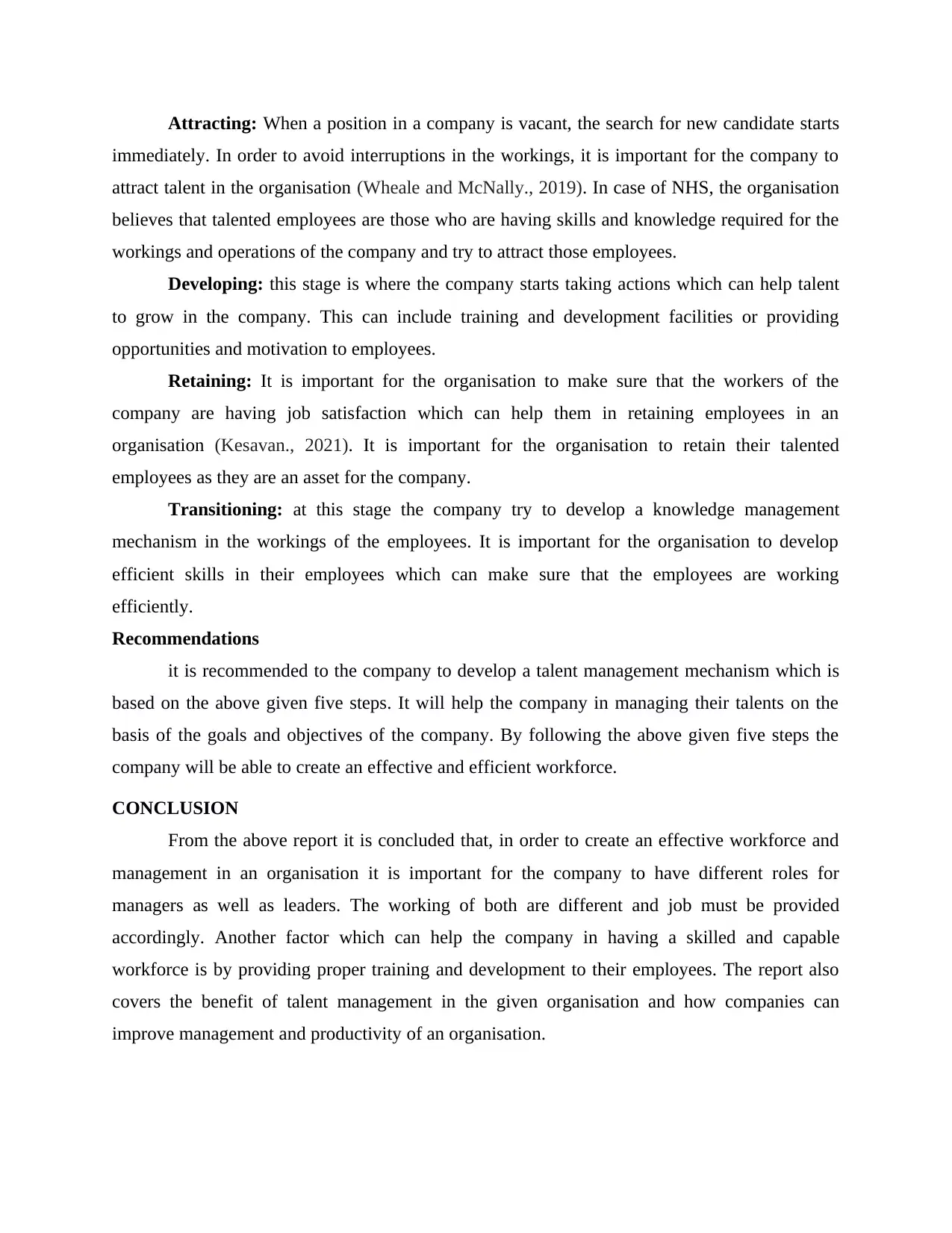
Attracting: When a position in a company is vacant, the search for new candidate starts
immediately. In order to avoid interruptions in the workings, it is important for the company to
attract talent in the organisation (Wheale and McNally., 2019). In case of NHS, the organisation
believes that talented employees are those who are having skills and knowledge required for the
workings and operations of the company and try to attract those employees.
Developing: this stage is where the company starts taking actions which can help talent
to grow in the company. This can include training and development facilities or providing
opportunities and motivation to employees.
Retaining: It is important for the organisation to make sure that the workers of the
company are having job satisfaction which can help them in retaining employees in an
organisation (Kesavan., 2021). It is important for the organisation to retain their talented
employees as they are an asset for the company.
Transitioning: at this stage the company try to develop a knowledge management
mechanism in the workings of the employees. It is important for the organisation to develop
efficient skills in their employees which can make sure that the employees are working
efficiently.
Recommendations
it is recommended to the company to develop a talent management mechanism which is
based on the above given five steps. It will help the company in managing their talents on the
basis of the goals and objectives of the company. By following the above given five steps the
company will be able to create an effective and efficient workforce.
CONCLUSION
From the above report it is concluded that, in order to create an effective workforce and
management in an organisation it is important for the company to have different roles for
managers as well as leaders. The working of both are different and job must be provided
accordingly. Another factor which can help the company in having a skilled and capable
workforce is by providing proper training and development to their employees. The report also
covers the benefit of talent management in the given organisation and how companies can
improve management and productivity of an organisation.
immediately. In order to avoid interruptions in the workings, it is important for the company to
attract talent in the organisation (Wheale and McNally., 2019). In case of NHS, the organisation
believes that talented employees are those who are having skills and knowledge required for the
workings and operations of the company and try to attract those employees.
Developing: this stage is where the company starts taking actions which can help talent
to grow in the company. This can include training and development facilities or providing
opportunities and motivation to employees.
Retaining: It is important for the organisation to make sure that the workers of the
company are having job satisfaction which can help them in retaining employees in an
organisation (Kesavan., 2021). It is important for the organisation to retain their talented
employees as they are an asset for the company.
Transitioning: at this stage the company try to develop a knowledge management
mechanism in the workings of the employees. It is important for the organisation to develop
efficient skills in their employees which can make sure that the employees are working
efficiently.
Recommendations
it is recommended to the company to develop a talent management mechanism which is
based on the above given five steps. It will help the company in managing their talents on the
basis of the goals and objectives of the company. By following the above given five steps the
company will be able to create an effective and efficient workforce.
CONCLUSION
From the above report it is concluded that, in order to create an effective workforce and
management in an organisation it is important for the company to have different roles for
managers as well as leaders. The working of both are different and job must be provided
accordingly. Another factor which can help the company in having a skilled and capable
workforce is by providing proper training and development to their employees. The report also
covers the benefit of talent management in the given organisation and how companies can
improve management and productivity of an organisation.
Paraphrase This Document
Need a fresh take? Get an instant paraphrase of this document with our AI Paraphraser
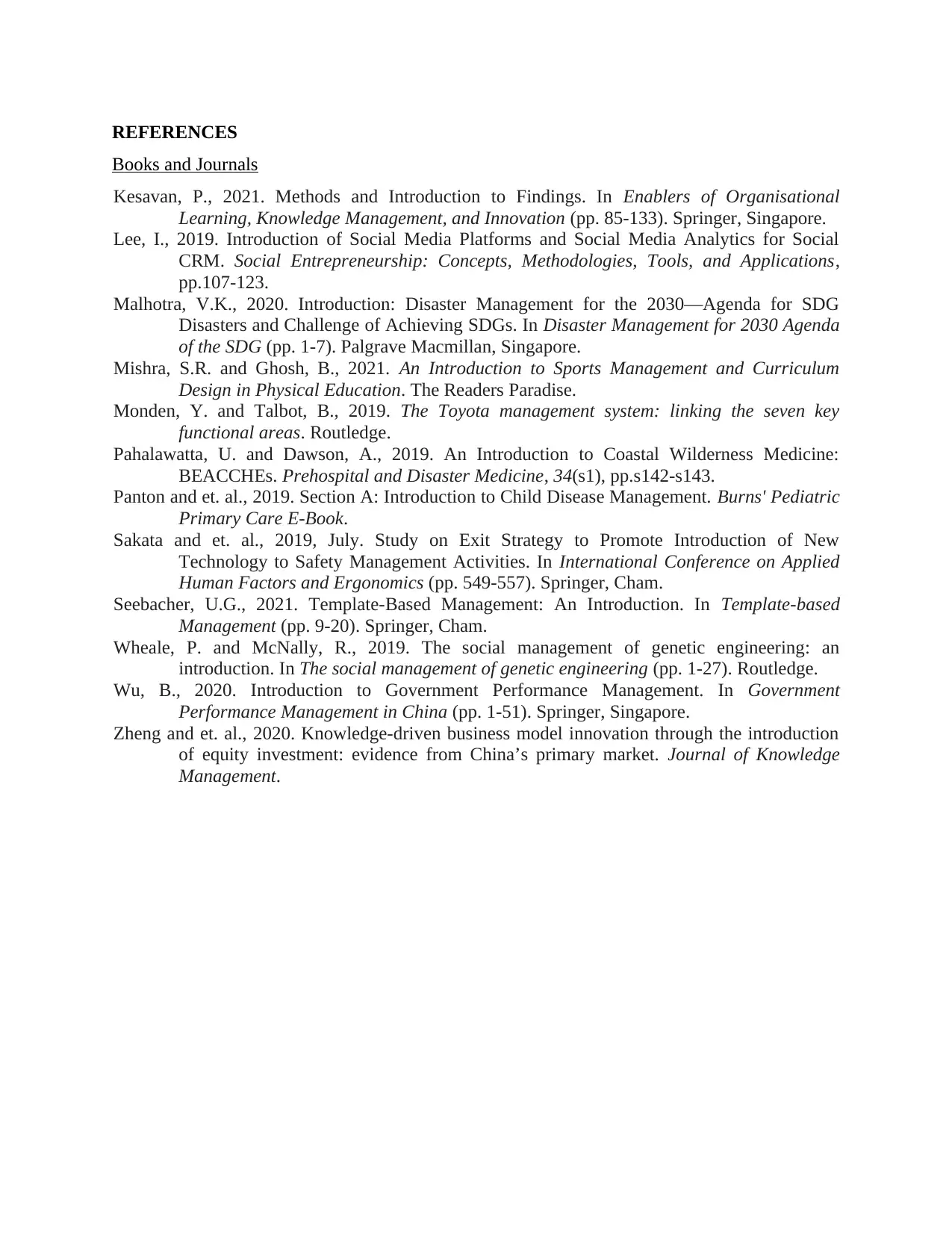
REFERENCES
Books and Journals
Kesavan, P., 2021. Methods and Introduction to Findings. In Enablers of Organisational
Learning, Knowledge Management, and Innovation (pp. 85-133). Springer, Singapore.
Lee, I., 2019. Introduction of Social Media Platforms and Social Media Analytics for Social
CRM. Social Entrepreneurship: Concepts, Methodologies, Tools, and Applications,
pp.107-123.
Malhotra, V.K., 2020. Introduction: Disaster Management for the 2030—Agenda for SDG
Disasters and Challenge of Achieving SDGs. In Disaster Management for 2030 Agenda
of the SDG (pp. 1-7). Palgrave Macmillan, Singapore.
Mishra, S.R. and Ghosh, B., 2021. An Introduction to Sports Management and Curriculum
Design in Physical Education. The Readers Paradise.
Monden, Y. and Talbot, B., 2019. The Toyota management system: linking the seven key
functional areas. Routledge.
Pahalawatta, U. and Dawson, A., 2019. An Introduction to Coastal Wilderness Medicine:
BEACCHEs. Prehospital and Disaster Medicine, 34(s1), pp.s142-s143.
Panton and et. al., 2019. Section A: Introduction to Child Disease Management. Burns' Pediatric
Primary Care E-Book.
Sakata and et. al., 2019, July. Study on Exit Strategy to Promote Introduction of New
Technology to Safety Management Activities. In International Conference on Applied
Human Factors and Ergonomics (pp. 549-557). Springer, Cham.
Seebacher, U.G., 2021. Template-Based Management: An Introduction. In Template-based
Management (pp. 9-20). Springer, Cham.
Wheale, P. and McNally, R., 2019. The social management of genetic engineering: an
introduction. In The social management of genetic engineering (pp. 1-27). Routledge.
Wu, B., 2020. Introduction to Government Performance Management. In Government
Performance Management in China (pp. 1-51). Springer, Singapore.
Zheng and et. al., 2020. Knowledge-driven business model innovation through the introduction
of equity investment: evidence from China’s primary market. Journal of Knowledge
Management.
Books and Journals
Kesavan, P., 2021. Methods and Introduction to Findings. In Enablers of Organisational
Learning, Knowledge Management, and Innovation (pp. 85-133). Springer, Singapore.
Lee, I., 2019. Introduction of Social Media Platforms and Social Media Analytics for Social
CRM. Social Entrepreneurship: Concepts, Methodologies, Tools, and Applications,
pp.107-123.
Malhotra, V.K., 2020. Introduction: Disaster Management for the 2030—Agenda for SDG
Disasters and Challenge of Achieving SDGs. In Disaster Management for 2030 Agenda
of the SDG (pp. 1-7). Palgrave Macmillan, Singapore.
Mishra, S.R. and Ghosh, B., 2021. An Introduction to Sports Management and Curriculum
Design in Physical Education. The Readers Paradise.
Monden, Y. and Talbot, B., 2019. The Toyota management system: linking the seven key
functional areas. Routledge.
Pahalawatta, U. and Dawson, A., 2019. An Introduction to Coastal Wilderness Medicine:
BEACCHEs. Prehospital and Disaster Medicine, 34(s1), pp.s142-s143.
Panton and et. al., 2019. Section A: Introduction to Child Disease Management. Burns' Pediatric
Primary Care E-Book.
Sakata and et. al., 2019, July. Study on Exit Strategy to Promote Introduction of New
Technology to Safety Management Activities. In International Conference on Applied
Human Factors and Ergonomics (pp. 549-557). Springer, Cham.
Seebacher, U.G., 2021. Template-Based Management: An Introduction. In Template-based
Management (pp. 9-20). Springer, Cham.
Wheale, P. and McNally, R., 2019. The social management of genetic engineering: an
introduction. In The social management of genetic engineering (pp. 1-27). Routledge.
Wu, B., 2020. Introduction to Government Performance Management. In Government
Performance Management in China (pp. 1-51). Springer, Singapore.
Zheng and et. al., 2020. Knowledge-driven business model innovation through the introduction
of equity investment: evidence from China’s primary market. Journal of Knowledge
Management.
1 out of 8
Related Documents
Your All-in-One AI-Powered Toolkit for Academic Success.
+13062052269
info@desklib.com
Available 24*7 on WhatsApp / Email
![[object Object]](/_next/static/media/star-bottom.7253800d.svg)
Unlock your academic potential
Copyright © 2020–2025 A2Z Services. All Rights Reserved. Developed and managed by ZUCOL.




